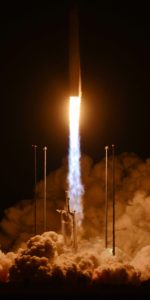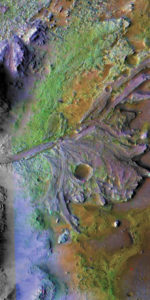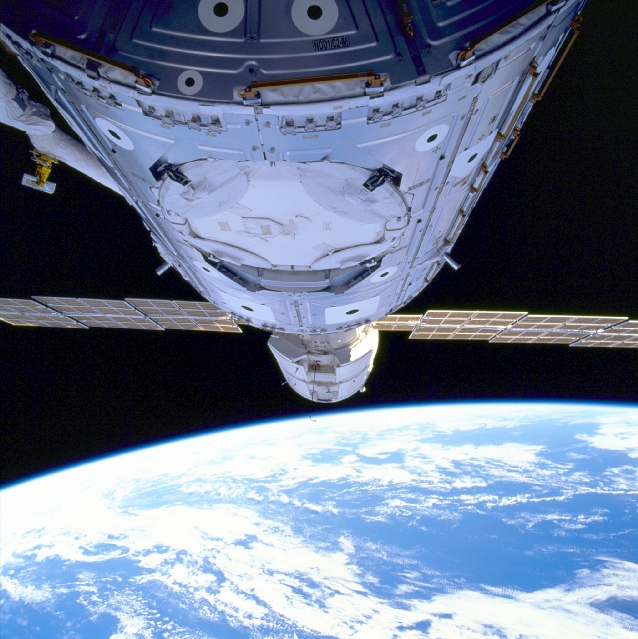
Twenty years ago, on 20 November 1998, Russia’s Zarya (“Dawn”) module—the first component of the International Space Station (ISS)—was launched from Site 81 at the Baikonur Cosmodrome in Kazakhstan, atop a mighty Proton-K booster. Less than nine minutes later, the 41-foot-long (12.5-meter) cylindrical module had separated from the final stage of its launch vehicle and settled perfectly into low-Earth orbit. Its function in those early days of the ISS program would to be to provide power, storage, propulsion and guidance for an infant space station which, in time, would grow to become the largest artificial satellite ever launched from Earth and the grandest and most complex engineering accomplishment in human history.
If 20 years ago marked a moment of triumph, then it is bitterly ironic that just five years previously, in 1993, the station effort hung on a knife-edge of cancelation. As outlined in last week’s AmericaSpace history article, the program began under President Ronald Reagan in 1984 and was initially named “Space Station Freedom”, a co-operative venture between the United States and the respective space agencies of Europe, Canada and Japan. In spite of the potential technological leaps offered by the station, it quickly became mired in complexity and drifted substantially over-budget throughout the late 1980s and early 1990s. When a new president, Bill Clinton, entered office in January 1993, he planned to cut NASA’s budget by 15 percent over five years to reduce the federal deficit. Although Clinton wanted Freedom to succeed and honor the United States’ commitment to its international partners, he desired a configuration with significantly reduced development, operational and utilization costs. In February 1993, NASA was directed to redesign Freedom for the final time.
Over the next few months, three options crystallized to produce plans for a dramatically slimmed-down station. At the same time, Russia was being increasingly courted as a potential future partner in the program and in April 1993 John Gibbons, head of the Office of Science and Technology Policy, noted that the United States, Europe, Canada and Japan were giving “full consideration” to the use of Russian assets in a consultancy role in the Freedom redesign process. For Russia’s part, the nation had already delayed the launch of its next-generation Mir-2 space station until at least 1997, following funding problems in the wake of the collapse of the Soviet Union, and it was clear that both sides needed each other’s involvement to allow their respective space programs to survive.
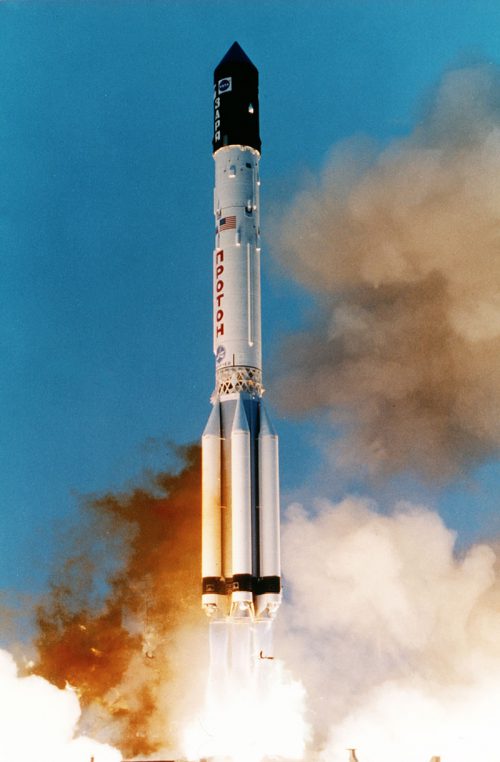
In June 1993, three options were submitted to the White House Advisory Committee on the Redesign of the Space Station, all of which—in the words of NASA Administrator Dan Goldin—were “technically viable” and provided “complete and accurate costs”. Option A used a combination of Space Station Freedom hardware and flight-qualified systems from other sources, to be assembled in four phases. Option B was derived from mature Freedom designs and made maximum use of current systems to enhance payload accommodations for its scientific users. Finally, Option C was a single-launch space station, with a seven-deck “core” module. In all three cases, Russia’s Soyuz-TM spacecraft would provide assured crew return capability. Also that June, an amendment to remove Space Station funding from NASA’s appropriation bill, effectively killing the project, failed by just one vote in the House of Representatives. The station had hit rock-bottom and the only direction now, it seemed, was upwards.
By August, Goldin announced the selection of Boeing as prime contractor and in January 1995 a $5.63 billion contract was signed to design and build the new station. In the meantime, Russia was formally brought into the program, which was renamed the “International Space Station”, and by the spring of 1994 the bones of the new outpost took shape. It would utilize about 75 percent of the hardware planned for Freedom, thus maintaining the United States’ and its partners’ initial investment, but redesigned to be less expensive and more capable. Its hardware would include an Integrated Truss Structure (ITS) to support solar arrays and radiators, U.S. laboratory and habitation modules, European and Japanese laboratories, a Canadian robotic arm and Russian-built science power platform, service module and—crucially—the Functional Cargo Block, which was later named “Zarya”, and which would become the first ISS element to fly.
Original plans envisaged Zarya to be launched via a Proton-K rocket from Baikonur in November 1997, after which a shuttle crew would arrive to deliver a U.S.-built connecting module, known as “Node-1”. Next would come Russia’s service module in early 1998, providing crew quarters and life-support systems, to be followed by the bulk of the rest of the station components. Construction was estimated to require 55 months, with the final assembly mission in mid-2002, after 13 Russian launches and 16 shuttle flights. From its inception in early 1994 to its completion in mid-2002, it was anticipated that the ISS would cost in the region of $17.4 billion.
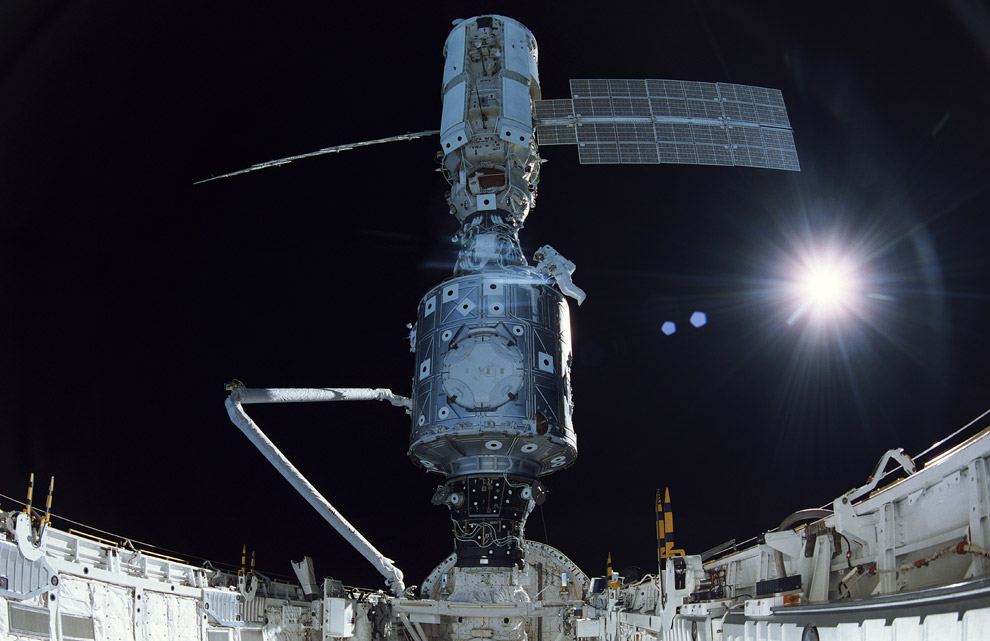
A House of Representatives amendment to cancel the project in June 1994 failed and Goldin declared this milestone as “a vote for America and for the American people and a vote for our future”. By early August, another amendment to terminate the ISS came to nought. In the meantime, in December 1994 the construction of the Zarya module got underway at Khrunichev State Research and Production Center in Moscow. Early the following year, NASA Space Station Program Manager Randy Brinkley and the Russian Space Agency’s Deputy of Piloted Spaceflight Boris Ostroumov signed government-level protocols for the U.S. purchase of Zarya at $190 million. And in August 1995, Boeing reached agreement with Khrunichev to complete and deliver Zarya into orbit. The module was structurally complete by December 1996, targeting launch late the following year. Elsewhere, Node-1—later to be renamed “Unity”—was also taking shape and was delivered to the Kennedy Space Center (KSC) in Florida in June 1997.
However, a third critical element in the early phase of construction had fallen behind schedule. Russia’s Zvezda (“Star”) service module, with its required crew quarters, life-support and propulsion systems, had fallen eight months behind schedule, moving from an original launch date target of March 1998 to no sooner than December. “We knew from the outset that building an International Space Station was going to be tremendously challenging,” said Dan Goldin at the time. “Space exploration is not easy or predictable. We will work through this schedule issue and we undoubtedly will face additional problems in the future, but we are well on our way to the realization of this world-class facility.” In order to mitigate the impact of the service module delay on the rest of the ISS construction sequence, plans were implemented to build a stand-in Interim Control Module (ICM) for reboost capability, if needed. In May 1997, the Zarya launch was rescheduled for no sooner than June 1998, followed by the delivery of the Unity node by the crew of shuttle mission STS-88 in July.
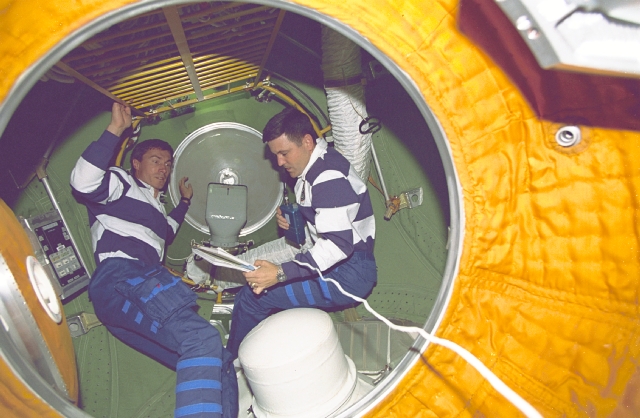
Notwithstanding this disappointing delay, progress continued. By October 1997, the two Pressurized Mating Adapters (PMAs)—a pair of interfaces, to be installed at either end of Unity—had been delivered to KSC for integration and Russia “reassured” its international partners that the service module would be ready to fly in December 1998. It was a promise that Russia would fail to keep, although Zvezda itself was making good strides towards launch, having passed a general designers’ review in Moscow with flying colors in September 1997. Elsewhere, Zarya was completed in January 1998 and transported to Baikonur in June for launch. By this time, however, Zvezda had slipped yet again and proud NASA declarations that 1998 was the “Year of the Space Station” seemed overly premature. In May, the partners were forced to confront the uncomfortable reality that Zvezda would not fly in December, after all, and the launch of Zarya was correspondingly pushed back to November and STS-88 to December. A new date for Zvezda was then pencilled-in for April 1999. NASA tried to downplay the seriousness of the delays, but the events underscored how dependent the partners were upon the newly in-from-the-cold Russia.
As 1998 entered its final months, all seemed to finally be on track. The STS-88 crew—Commander Bob Cabana, Pilot Rick Sturckow and Mission Specialists Jerry Ross, Nancy Currie and Jim Newman—had been training for over two years and were joined in July by veteran Russian cosmonaut Sergei Krikalev, who had previously been announced as a member of the first long-duration ISS expedition. As circumstances transpired, Krikalev and Cabana would become the first humans to board the new space station. And as Zarya speared perfectly to orbit on 20 November 1998, the arrival of humans on the ISS, and the dawn of a new era in international co-operation in space, drew inexorably closer.
FOLLOW AmericaSpace on Facebook and Twitter!
.




